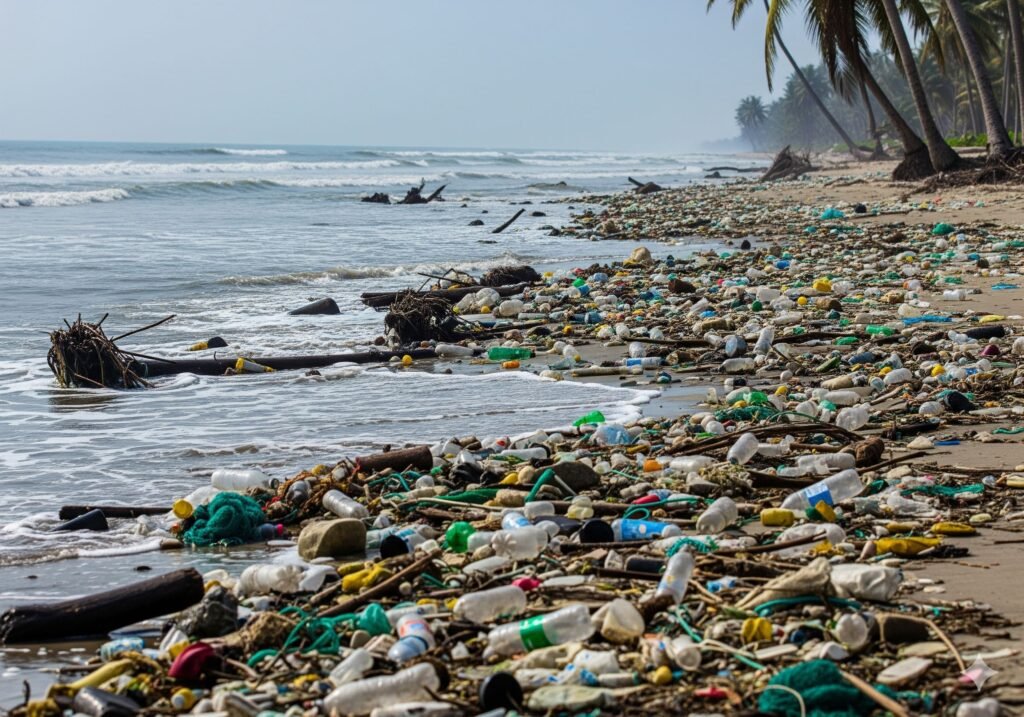
The pollution of plastic scrap presents an increasing threat to our planet. It influences both terrestrial and marine habitats. It is now more urgent than ever. Every year, millions of tons of plastic pour into our oceans. We already know that marine plastic pollution is damaging to many kinds of aquatic life. Wildlife often consume or get caught in plastic debris.
A practical solution to this crisis is proper management of plastic waste. Plastic waste can be reduced by recycling, reusing, and reducing the use of plastic. But single-use plastics are still a problem.
There’s also the issue of microplastics, small plastic particles. They are scattered in all oceans. These particles are a threat to the health of marine life and human beings.
And it is finally provoking action from governments and organizations. Initiatives are also being put into place to stem plastic scrap pollution. This struggle also requires awareness and education.
There are promising developments in biodegradable plastics. But other materials are starting to upend the status quo. We can overcome plastic pollution and preserve our environment together.
Understanding Plastic Scrap Pollution
Plastic scrap pollution is widespread. It affects ecosystems on a global scale. This issue demands our urgent attention.
The origins of plastic scrap pollution are manifold. Consumer habits play a significant role. Industries contribute substantially as well.
A staggering amount of plastic waste goes uncollected. Many plastics are not biodegradable, leading to long-term pollution. This results in enduring environmental impact.
Here are key sources of plastic scrap pollution:
- Single-use plastics: Items like bags and straws.
- Plastic packaging: Widespread in retail markets.
- Discarded fishing nets: Often found in oceans.
- Improperly disposed waste: A common urban issue.
Effective plastic waste management is essential. Recycle and reuse are the primary approaches. However, implementation varies across regions.
Addressing this problem requires a comprehensive approach. It should involve international cooperation. Public awareness campaigns can foster change in behavior.
Understanding the dynamics of plastic pollution can drive solutions. Informed actions make a significant difference. Everyone has a role to play in reducing pollution.
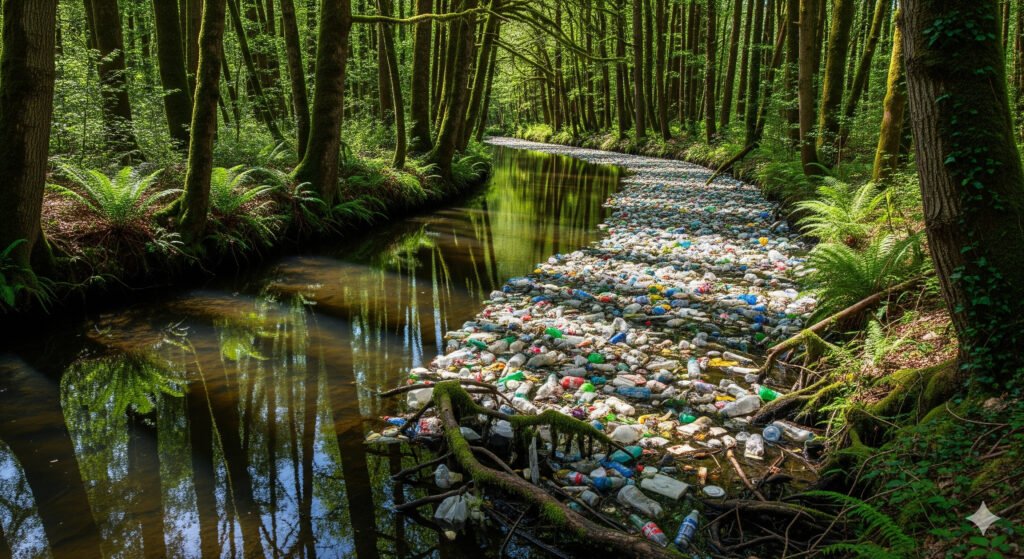
The Journey of Plastic: From Use to Waste
Plastic’s lifecycle begins with production. Many industries rely on it for packaging and products. There are many reasons why it is often chosen, one being its widespread use and strength.
When used, a not small amount of plastic is discarded. Consumers often discard them after brief use. This contributes heavily to pollution.
The pathway from use to garbage can be expressed as follows:
Manufacturing: Creation of plastic products.
Consumption: Consumption by households and businesses.
Disposal: Items are thrown away.
Unfortunately, disposal practices are inadequate. A great deal of the plastic waste winds up in landfills or incinerators. “The vast majority is going out there into natural habitats.
Recycling is increasing, but it comes with its own challenges. Facilitative restoration reduces contamination of materials that impede recycling activities. Sufficient segregation is the key to success.
Up and coming: the management of plastic waste. Recycling technologies are getting better. Fostering a culture of reuse can also significantly reduce waste. If we understand this journey, we will see that every step along the way needs to be changed.
Marine Plastic Pollution: Oceans Under Threat
Our oceans have seen a massive uptick in plastic garbage. This crisis is proliferating and poses a danger to marine ecosystems worldwide. The damage is deep and broad. Large pieces and microplastics are the two main fractions of marine plastic pollution. Plastics are routinely eaten by marine wildlife that confuse them for prey. And that brings about severe health problems or death.
Marine animals also become ensnared in plastic debris. Animals, including turtles, seabirds, and fish, are especially at risk. Such captivity inevitably leads to injury, drowning, or starvation.
Every year, nearly 8 million metric tons of plastic are released into the oceans. This is primarily due to ineffective waste management and disposal practices. These garbage patches are then spread around the world by ocean currents.
One really alarming example is the Great Pacific Garbage Patch. This massive collection of wreckage is having a devastating impact on marine life and the human populations living in the vicinity of the wreckage.
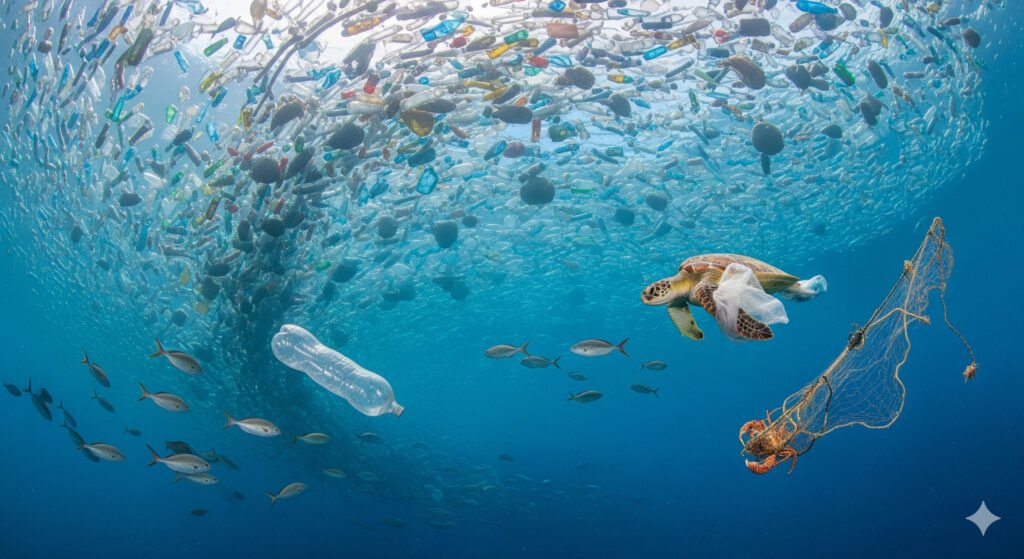
Marine litter is being combated. These include:
Beach clean-up programs: Community participation in the removal of marine debris.
Biodegradable Material Advancement: Aiming to Minimize Total Dependence on Plastic.
Adoption of more stringent waste management standards: Improving national and local infrastructures.
It is crucial to raise awareness about marine plastic pollution. When people are educated to understand the consequences, they tend to treat the environment better. International cooperation is equally essential. Collaboration enables a greater scope of strategy and enforcement. The challenge of marine plastic pollution must be addressed globally in a spirit of shared responsibility.
Human development is affected by the health of the ocean. Cleaner seas mean resources that can be enjoyed from one generation to the next. We must work together to combat ocean pollution if we want marine animals to survive.
Microplastics: The Invisible Danger
Microplastics are small pieces of plastic, frequently not visible to the human eye. This flotsam consists of small pieces that are broken-down remnants of larger plastic debris. They do exist both in water and on land.
Microplastics are small, but their impact is significant. This particle is ingested by the marine life, mistaking it for food. Additionally, this feeding can also lead to malnourishment and starvation in animals.
Even people aren’t off the hook when it comes to microplastics. These particles have been found in different food types. Such consumption may cause unexpected health hazards over time.
Microplastics are so ubiquitous that it’s difficult to see how they could ever be managed. They’re transmitted by oceans and rivers — even air. Solutions are needed to counteract the large-scale dispersal of these agents.
To address the microplastic problem:
- Tighten up waste management to keep plastic from breaking down.
- Explore biodegradable substitutes for traditional plastics.
- Increase public knowledge about the effects of microplastics on ecosystems.
The connection between considering and addressing microplastic pollution is vital for the health of the environment. Specific measures can be taken to avert such dismal scenarios for our children and their children. Microplastics are small pieces of plastic, most commonly so minute that they can’t be seen with the naked eye. These flakes are little “shards” that are supposed to be precisely that: minuscule remnants of larger pieces! They work in the water as well as on land.
Microplastics are small, but their impact is significant. This particle is ingested by the marine life, mistaking it for food. Additionally, this feeding can also lead to malnourishment and starvation in animals.
Even people aren’t off the hook when it comes to microplastics. These particles have been found in different food types. Such consumption may cause unexpected health hazards over time.
Microplastics are so ubiquitous that it’s difficult to see how they could ever be managed. They’re transmitted by oceans and rivers — even air. Solutions are needed to counteract the large-scale dispersal of these agents.
To address the microplastic problem:
- Tighten up waste management to keep plastic from breaking down.
- Explore biodegradable substitutes for traditional plastics.
- Increase public knowledge about the effects of microplastics on ecosystems.
The understanding that microplastic pollution and the pursuit of curbing it can not be separated from each other is more essential for environmental health. There are ways to address and mitigate such pressing issues for future generations.
Plastic Waste Management: Current Challenges
Plastic waste management is a serious concern at the global level. Poor infrastructure and systemic deficiencies compound the issue. The lack of recycling facilities in various parts of the world is a significant issue.
Rates of recycling are often dismal, falling short of what is needed to handle the volume of plastic produced. Mixed plastics challenge the industry, as the materials are so diverse. Sorting and recycling these materials efficiently, however, demands new technologies.
Single-use plastics pose a challenge for existing management systems. You can’t easily recycle things like straws and bags. They often end up in landfills or as litter, which worsens pollution.
Poor countries have additional obstacles in dealing with plastic waste. Resource limitations usually restrict effective measures. Hence, waste is piled up, whether in urban or rural locations.
Challenges of plastic waste management are as follows:
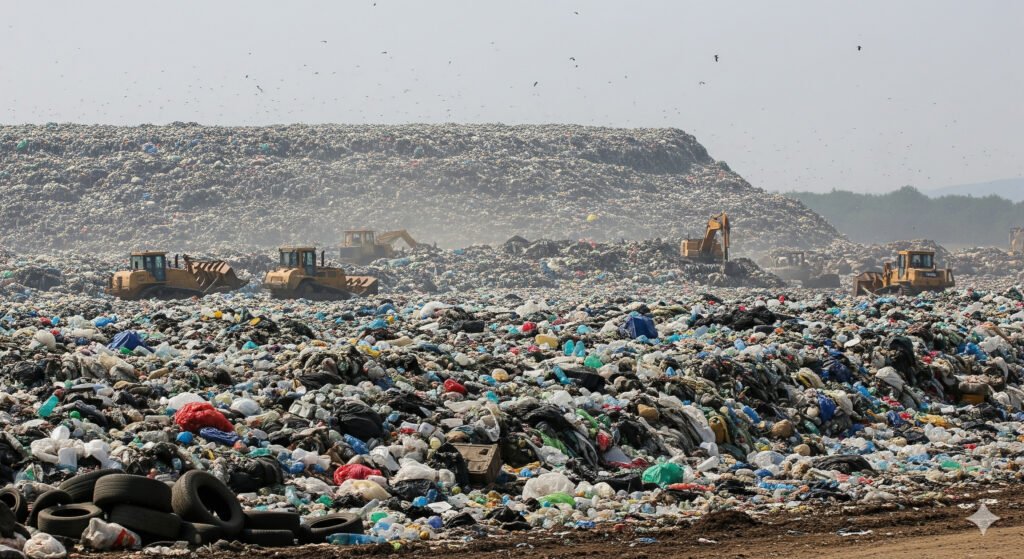
- The absence of uniform recycling systems
- Inefficient waste collection systems
- Public desensitization and ignorance
These restraints are best addressed through solidarity practices. We need government, business, and individuals to come together. The most effective way to address plastic waste efficiently is to innovate and invest in sustainable solutions for its management.
Solutions and Innovations in Plastic Waste Management
New ideas could give hope for the plastic waste problem. Innovative concepts and technologies are springing up all over the world. These are innovations designed to reduce plastic pollution.
Biodegradable plastics are among the essential developments. They degrade faster than traditional plastics. They are a significant next step in the war against waste.
Advanced methods in recycling are also important. Chemical recycling breaks plastic down into its molecular building blocks, such as basic chemicals and chemical feedstock. This step could produce new plastics or other materials.
It is essential to invest in more effective collection systems. Smart trash bins and auto-sorting plants make things more efficient. They increase the likelihood that plastics will be recycled correctly.
Business participation is yet another critical factor. Businesses are implementing sustainable practices to decrease the use of plastic. It is now a trend to have environmentally friendly packaging and reusable items.
Some potential solutions regarding plastic waste management are:
- Biodegradable and plant-based materials
- Chemical recycling and pyrolysis
- Up-to-date sorting and collection technologies
The general public needs to be educated, and awareness needs to be created. People can be taught about the benefits of recycling. Trivial acts by individual consumers are major forces that drive cutting-edge waste reduction.
The Role of Policy and International Cooperation
Policy is key to addressing plastic scrap pollution. The use of plastic is being restricted by governments worldwide. These regulations are effectively an attempt to eliminate plastic pollution. International collaboration is essential. These include bilateral and multilateral agreements, including the Basel Convention. These partnerships are being used to solve cross-border waste issues.
Together, much can be accomplished. Policies need to be holistic to be successful. They should include all forms of plastic waste.
Key components of effective policies are summarized:
Restrictions on single-use plastics
Rewards for recycling and collecting less trash
Support for sustainable alternatives
It cannot be solved by policies alone. Continuous international cooperation is necessary for a lasting change. It is only by working together that we can end the blight of plastic scrap pollution across the globe.
Community Action and Individual Responsibility
Imagine that, people power at its best for the better good. Community engagement is key in the struggle against plastic pollution. Local initiatives, such as beach clean-ups, can have a significant impact. These actions reduce waste and motivate others.
People can also do their part by changing their routines. Small, incremental changes add up significantly over time. Making individual decisions that contribute to a more sustainable way of life.
Steps you can take:
- Avoiding single-use plastics
- Joining local clean-up campaigns
- From brands that practice eco-friendly policies
Communities, collectively, have more of a ripple effect.” This collaborative work helps clean the air and raise awareness. It is collaboration that makes change feasible and self-perpetuating.
The Future: Toward a Circular Economy
The term circular economy is in vogue. It is centered on the themes of waste reduction and material use. This sustainable model contrasts with the current linear system.
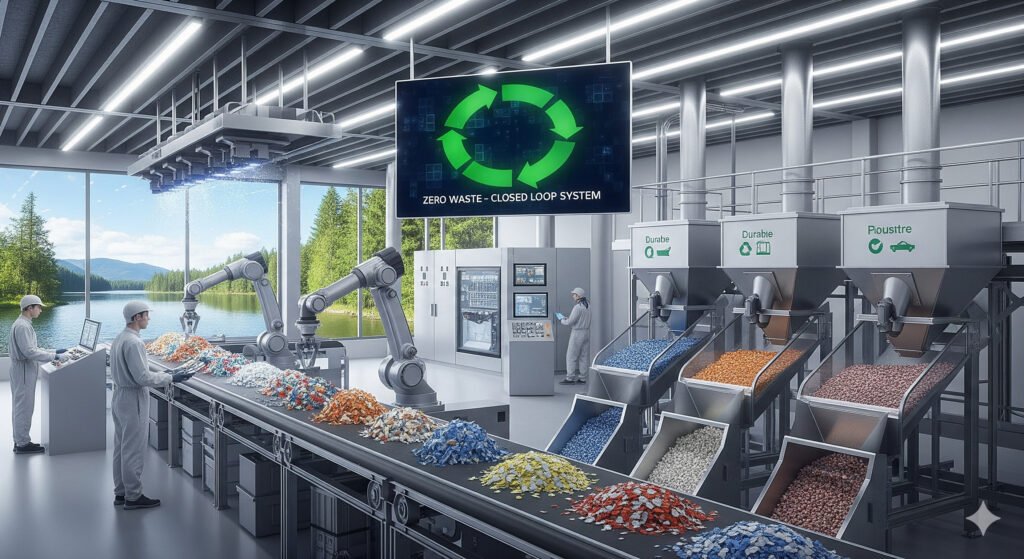
A closed-loop economy offers numerous environmental and economic benefits. It encourages products to be reused, repaired, or recycled. These guidelines are intended to minimize the use of new resources.
Some steps in the direction of the circular economy are:
• Building products to last and be repaired
• take-back programs to recover materials for recycling by manufacturers
• Offering motivation to recycle and landfill less
Moving to this type of system can only occur through intersectoral collaboration. This will require participation by businesses, governments, and consumers. Not only would the change result in reduced pollution, but it also offers the potential for economic growth.
- Adopting a circular economy can reduce reliance on virgin materials. It helps make the future more sustainable. If we put a value on resources, we can protect the health of the Earth for our children.
Conclusion: Combating Plastic Scrap Pollution Together
The honeycomb-like waste plastic scrap pollution has become a significant environmental problem. We need to work together to solve it. This is a global issue, and it is time everyone does their part.
All of this will require the cooperation of communities, governments, and industries. We can work together to introduce waste control plans that benefit both people and the Earth. Working together is crucial to addressing plastic pollution.
Individuals also contribute significantly. Personal decisions — including choosing products with less plastic and supporting more sustainable practices — are essential. It’s all the little things that add up to make a big difference, though.
We can fight plastic scrap pollution by being informed and engaged. What we do will make a difference to the sustainability of our planet for future generations. Together, we can make a lasting difference.

One Response